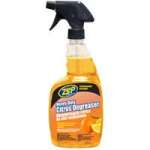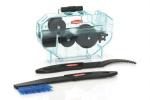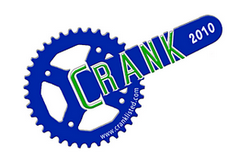First use impression and review as used on my commuter bike:
The Zep citrus degreaser works great on breaking-down or dissolving lubricant-laden grime. Plus, it’s biodegradable for easy disposal. I used it straight from the bottle. At $10 to $11 dollars a gallon, fairly inexpensive too. I found it at the local hardware store–highly recommended.
Next is the XLC chain cleaner. The action of the moving chain drives a geared cog, which rotates the brushed cleaning wheel. Fairly effective at removing MOST of the grime from a chain. In comparison with my usual chain-cleaning method, the mechanism will not remove the built-up grime on the outside of chain plates near the rollers that a tooth-brush and a good eye would catch. Since the chain is encased within the housing, the alignment of the chain cleaner is important as you rotate the cranks backward. In other words, the mechanism will bind if the entry angle of the chain exceed the guides. Additionally, the left-side picture of the chain cleaner shows a square piece of black open-cell foam. The purpose of this foam is to act as a squeegee as the chain exits the cleaner. The squeegee is fairly effective, however, please be aware that enough solvent will exit and accumulate on your drivetrain and may drip on your drop cloths on the floor. $25 at your LBS–hesitantly recommended.
Recommendation(s):
- Use a good, biodegradable cleaner that acts fast. The longer you use the chain cleaner, the more solvent will exit the mechanism.
- Change your solvent as needed. It doesn’t make sense to wash your chain in solvent that’s saturated.
- Lay down drop cloths. The using the chain cleaner can make a mess if the chain is not smoothly and steadily moved through the cleaner.
- Dry-off the chain with a pile-type cloth such as an old hand towel. Dry the chain as much as possible before applying new lubricant.
- Use a bike stand or something similar to hold the bike still while you rotate the drivetrain backwards.
- For the XLC engineers:
- The compartment containing the foam squeegee does not drain into the main chamber. Eventually, the accumulating fluid level will prevent effective squeegee action, and draining to the outside of the cleaner body. Allow a drain port at the bottom of the chamber.
- Alternate the application angle of the cleaning brushes from normal to the chain plate to a more acute angle. This will improve the sweep area of the brushes leaving less residue on the chain plates.
Conclusion:
My race bike receives a higher frequency of cleaning (that is, after every ride) than my commuter bike does. Thus, this chain cleaner would be a good method for cleaning the accumulated chain grime on the commuter. My race bike however, will continue to receive the wash cloth and solvent method for the chain since there is a much lower level of road and oil grunge. Is the $25 worth it? At this point, only if your chain cleaning involves a lot of accumulated grime and crap, and at that point, be prepared to do a lot of wiping down and cleaning-up. On the other hand, if your chain has a master-link, use a dip tank and a tooth-brush. You’ll have faster, cleaner results with less clean-up involved.
Edit 1/29/2013:
The foam squeegee has degraded after the third use somewhat decreasing its effectiveness. I’ll have to locate and adapt an open-cell piece of foam to replace it as a look at XLC’s web site doesn’t show any replacement parts outright.
Edit 2/13/2013:
The foam squeegee has completely fallen apart now on the fourth or fifth use.









Leave a comment